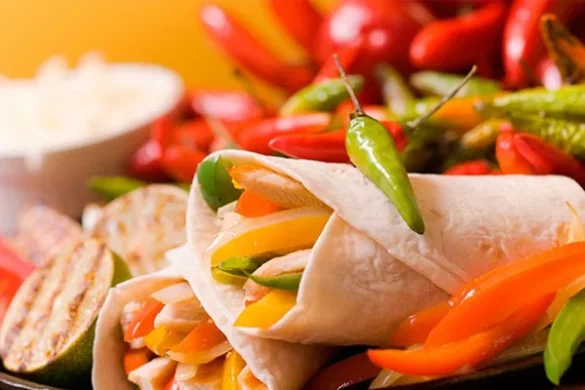China is a vast country with a rich culinary heritage, and Chinese breakfast culture reflects the diversity of its regions and the historical influences on its food traditions. Breakfast is considered the most important meal of the day in China, and the Chinese take pride in creating balanced, flavorful, and nutritious morning dishes. In this article, we will delve into the various types of breakfasts consumed across different regions of China, highlighting their unique ingredients, preparation methods, and cultural significance.
The Traditional Chinese Breakfast:
1. Soybean Milk and Deep-Fried Dough Sticks
Taste: sweet
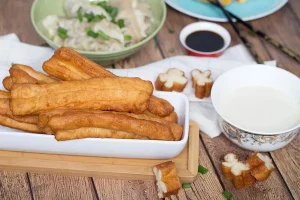
This breakfast set usually appears together. The two components are the most common breakfast combination. Some locals also like to have deep-fried dough sticks with rice congee.
Soybean milk is made with a blender. You can find freshly blended or boiled soy milk in disposable cups at most breakfast stalls. It’s very convenient for a take-out.
Deep-fried dough sticks are long, brown, deep-fried sticks of dough. You can eat one as it is or dip it in some soybean milk, which has a better taste.
2. Steamed Buns
Taste: salty or sweet
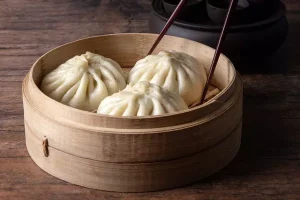
Chinese people eat steamed buns at any meal, but they are especially popular at breakfast.
There is an almost endless variety of flavors, both salty and sweet. Salty flavored buns are stuffed with ground pork, eggplant, eggs, and vegetables, such as chives. Sweet flavored buns are stuffed with bean paste, creamy custard, sesame seeds, and sugar. They are also very convenient for a take-out.
Some stores sell steamed buns in a small basket with about eight small steamed buns in it. These steamed buns are usually called ‘small basket buns’.
3.Wontons and Dumplings
Taste: salty
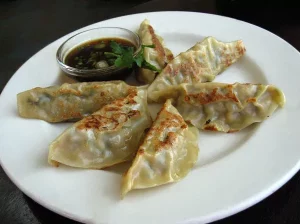
Wontons and dumplings are two similar types of food, which are comprised of a square or round wrapper (a dough skin made of flour and water) and fillings.
Wontons can be boiled in a fragrant and watery broth, steamed in a bamboo steamer, or fried in a high-heat wok. Sometimes, wontons are also served with little noodles to make ‘wonton noodles’.
They are available with a large variety of fillings, such as ground pork, shrimp, fish, mushrooms, and other vegetables.
Read more:
Homemade Dumplings Recipe: Step-by-Step Tutorial
The Price of Dumplings: A Complete Overview
4. Wheat Noodles
Taste: salty
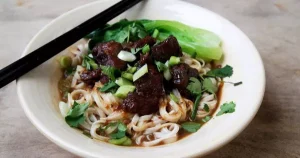
In northern China, where wheat is more commonly eaten, a bowl of hot and flavorful wheat noodles is a popular breakfast dish.
In Wuhan, hot-and-dry noodles are eaten at breakfast by almost everyone. This dish is prepared by frying boiled noodles, drying them, then scalding them quickly and adding spicy condiments. The result is chewy and quite tasty.
Lanzhou stretched noodles are a popular halal food in China. The added ingredients are usually beef or lamb.
Now, wheat noodle stores have spread to other parts of China, so you can have wheat noodles in nearly every city.
5. Rice Noodles
Taste: salty

Rice noodles are a good choice if you are allergic to gluten. They are made of rice although they look like wheat noodles and the taste is different. Rice noodles are more commonly eaten in the south, especially in Guangxi and Yunnan provinces.
Guilin rice noodles are a very famous and popular cheap meal. Local people eat the dish not just for breakfast, but also for lunch or dinner. This snack is made with boiled rice noodles, fried peanuts or soybeans, thin slices of different meat, chopped scallions, pickled mustard, and other ingredients that you can choose according to your preferences.
6. Pancakes with Eggs
Taste: salty

These pancakes (jiang bing) are quickly-cooked thin pancakes or crepes filled with typically savory or spicy ingredients. As popular street food in China, they can be easily found and are a favorite “breakfast on the run”.
The pancakes are usually wrapped around a deep-fried crispy dough slice and topped with fried egg, finely chopped mustard pickles, scallions, coriander, and a spicy sauce.
7. Steamed Glutinous Rice
Taste: salty or sweet
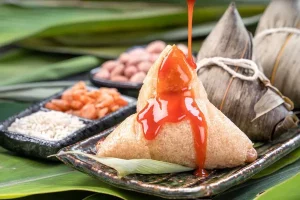
Rice dumplings are made of steamed glutinous rice wrapped in bamboo leaves. They can be bought at street stalls and have a variety of tasty fillings, including the sweet flavor of red bean paste, egg yolk, and lotus seeds, or the salty flavor of fatty pork and chestnuts. Zongzi are especially popular as a festival food and are frequently eaten during the Dragon Boat Festival. Learn more about Rice Dumplings.
Read more:
How to Make Zongzi: A Step-by-Step Tutorial
8. Tofu Pudding
Taste: salty or sweet
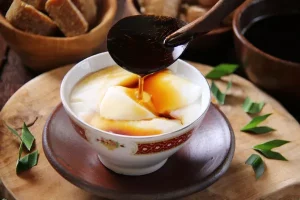
Tofu pudding is a popular Chinese snack made with very soft tofu, which is made from raw beans.
Flavors of tofu pudding vary by region. In the north, people like to have salty tofu pudding with soy sauce or salt, or with meat. However,ing a bowl of dan dan noodles on the go, Chinese breakfasts are a celebration of the nation’s culinary diversity and time-honored traditions.
Breakfast Habits In Various Regions Of China:
1. Dim Sum: The Cantonese Breakfast Delight
Originating from Guangdong province, dim sum is a beloved breakfast tradition that has gained immense popularity worldwide. A dim sum breakfast typically features an assortment of small, flavorful dishes served in bamboo steamers or on small plates. Steamed dumplings with various fillings such as shrimp, pork, or vegetables are iconic dim sum items, as are rice rolls filled with meat or seafood and drizzled with soy sauce. Other favorites include steamed buns, custard tarts, and sesame balls filled with sweet bean paste. Dim sum gatherings are social events, where families and friends come together to savor a delightful and communal breakfast experience.
3. Jiangsu and Zhejiang: Sweet and Savory Pastries
The regions of Jiangsu and Zhejiang boast a unique breakfast culture with a focus on both sweet and savory pastries. Savory options include “Suzhou-style mooncakes,” a flaky pastry filled with minced pork, and “Shanghai-style shengjian mantou,” pan-fried buns with juicy meat filling. On the sweet side, “Ningbo tangyuan” are glutinous rice balls filled with sweet sesame or red bean paste, and “Hangzhou xiaolongbao” are delicate dumplings filled with sweet red bean paste and osmanthus flowers.
3. Beijing Breakfast: Jianbing and Douzhi
In the bustling streets of Beijing, you’ll find locals starting their day with “jianbing,” a popular savory street food pancake. Made from a batter of wheat and mung bean flour, jianbing is filled with scrambled eggs, cilantro, scallions, and crispy wonton crackers. Chili sauce and hoisin sauce are added for an extra kick. Accompanying jianbing is “douzhi,” a fermented mung bean milk beverage with a slightly sour taste. This breakfast duo offers a delightful contrast of flavors and textures.
4. Sichuan Spice: Dan Dan Noodles and Sichuan Pancakes
Sichuan province is famous for its bold and spicy flavors, and its breakfast offerings are no exception. “Dan dan noodles” are a fiery and aromatic dish made with minced pork, chili oil, Sichuan peppercorns, and preserved vegetables, served over chewy wheat noodles. For a milder option, locals enjoy “Sichuan pancakes,” which are thin, crepe-like pancakes filled with sweet or savory fillings like red bean paste or minced meat.
5. Muslim Influence: Xinjiang’s Nang Bread and Lamb Skewers
In the Xinjiang region, where Islamic influences are prominent, breakfast takes on a unique character. “Nang” is a type of flatbread, traditionally baked in a tandoor oven, and it comes in various flavors such as sesame, onion, and cumin. Nang is often paired with a hearty bowl of lamb soup and skewers of succulent lamb or beef, seasoned with aromatic spices like cumin and chili.
6. Taiwan’s Breakfast Culture
Taiwanese breakfast culture is vibrant and varied, featuring an assortment of delicious dishes. “Dan bing” is a popular breakfast roll filled with egg, cheese, and various toppings like ham or bacon. “Soy milk” is a classic beverage made from soybeans, often served with “youtiao” for a delightful combination. Additionally, “scallion pancakes” and “rice rolls” are common choices for a satisfying start to the day.
Conclusion
Chinese breakfast cuisine is a reflection of the nation’s diverse culinary heritage, with each region boasting its own unique flavors and traditions. From the comforting congee and youtiao combination to the vibrant and spicy offerings of Sichuan, breakfast in China offers a delightful culinary journey. These morning delights not only nourish the body but also embody the cultural richness and social significance of breakfast in Chinese communities. Whether indulging in dim sum with family or savoring a bowl of dan dan noodles on the go, Chinese breakfasts are a celebration of the nation’s culinary diversity and time-honored traditions.

